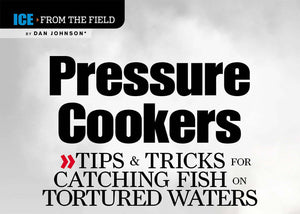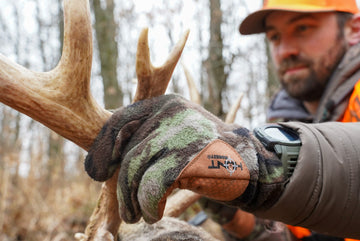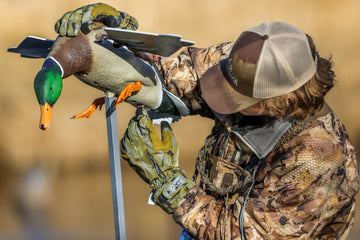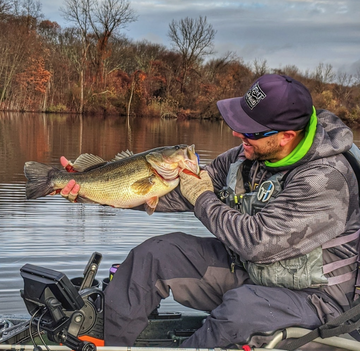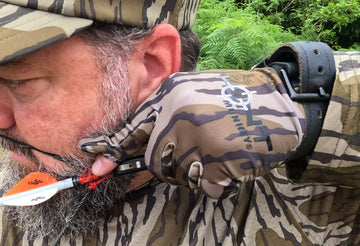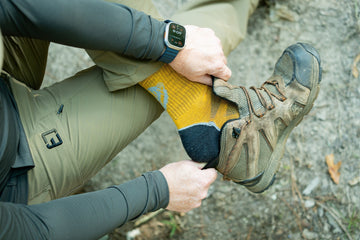Pressure Cookers TIPS & TRICKS FOR CATCHING FISH ON TORTURED WATERS
Dec 20, 2021
Pressure Cookers TIPS & TRICKS FOR CATCHING FISH ON TORTURED WATERS
ICE ANGLERS DREAM OF TARGETING unpressured fish in secluded hotspots, for obvious reasons. Fishing pressure reduces fish numbers and frequently alters the survivors’ location and behavior. This is especially true of the murderous, mass hysteria kind of pressure so common when word of a hot bite hits social media. Even so, you can still enjoy fine fishing and banner catches on beleaguered fisheries besieged by the bucket brigade.
Let’s start with walleyes. Winter walleye location in many lakes begins with the fish in relatively—if not surprisingly—shallow water. As winter marches on, many fish move progressively deeper, before returning to shallower water just before ice-out. These spots are often adjacent to spawning areas. However, a variety of factors including fishing pressure can throw these guidelines out the window. First-ice walleyes are quick to abandon shallow feeding areas when the hubbub of cleats, spuds, scoops, tracks, shacks, and augers echoes through the underwater world.
The mob’s typical response is to pack up and move deeper. Once they leave, few anglers look back toward shore. That’s a mistake, because abundant forage can lure hungry ’eyes back to the shallows once the ruckus subsides. “It’s common for pressured fish to come back to shallow areas on gradually tapering basin lakes,” says veteran guide Jon Thelen. “Minnesota’s Upper Red Lake is a prime example, but it happens across the Ice Belt. Searching the shallows with lures that appeal to all the walleyes’ senses, which are easy for the fish to detect and tempting once they move closer, is a great way to track down fish that have returned to the shallows.”
Walleyes also move shallow in lakes with ample structure. One of my favorite mesotrophic bass-panfish lakes a short cast north of Minnesota’s Twin Cities metro area is a great case in point. It’s hit hard by fishing pressure, most of which is directed at deep structure and flats. Throughout the winter, walleyes from 16 to 25 inches and up routinely move onto weedy flats in 4 to 6 feet to feed on yellow perch. Apparently, the 4- to 6-inch perch roaming the weeds are preferable to the hordes of tiny perchlings infesting the 15- to 35-foot depths nearby. Conversely, foot-long walleyes are common catches in those deeper areas, but not in the shallows with the bigger fish.
Water clarity is excellent in the area of the lake where this shallow pattern occurs. Peak fishing action coincides with low-light walleye feeding periods, but patient ice-men pick up weed fish here and there all day long. A large, shallow basin of the same lake—stained with sediments and algae—also hosts a stellar wall-eye bite most of the winter. This, too, is off the radar of anglers congregated over deep water on the main lake.
Perch aren’t the only prey that draws walleyes shallow. Longtime Minnesota Department of Natural Resources fishery biologist Roger Hugill (also a diehard angler and veteran SCUBA diver) explained the bluegill connection to me years ago, and it still holds true today. “Blue-gills may not be the best food source for walleyes, yet we know adult walleyes, being opportunistic feed-ers, frequently take advantage of the bluegill’s poor visual acuity during low-light situations,” he said. “Most of the bluegills eaten by walleyes are 1 to 2 years old (following their sec-ond or third summer of growth). “I have also seen dead walleyes with bluegills too large to swallow lodged in their gullets.”

Hugill said shallow, weedy flats in the 6- to 12-foot range are key areas to target bluegill-pattern wall-eyes under the ice. “Shallow water is less of a deterrent than most people think,” he noted. Not just on small waters, either. Minnesota’s legend-ary Mille Lacs Lake is just one classic big-water walleye fishery where legions of anglers bypass prime salad bars that are flush with fish. You can catch walleyes in the weeds all winter in Isle Bay and other similar areas, but few people fish there.
In such scenarios, presentation isn’t as key as getting away from the crowd. A 4-inch sucker min-now works wonders in clear shallows, while aggressive jigging attracts and triggers ’eyes in stained or other lowvis situations. When dealing with pressured walleyes in the midst of the mob, however, pre-sentational tweaks can be critical. On deep offshore structure such as hard-hit breaks, bars, and flats, shell-shocked walleyes often idle in to check out jigs and lightly tethered minnows, only to turn up their noses or worse, dart away in a panic.
Iconic iceman Brian “Bro” Bros-dahl sweetens the pot with a super-subtle livebait rig consisting of a small leech impaled on a fine-wire hook and light, lowvis line. “Even heavily pressured walleyes in clear water have a hard time turning down this deal,” he says. “Saving leeches from late summer or fall is key, since they can be extremely hard to come by in winter.”
Another presentational trick that works for pressured walleyes and other predators on ice and in open water is hooking the minnow so it rides on its side. It works with a variety of jigs, though I’ve had best results on banana-style heads. Gently fluttering and occasionally twitching the bait has produced strikes from tough-bite walleyes and saugers for me from the Canadian Shield to the Mississippi River and a variety of shallow, fertile fisheries—even the shell-shocked south shore of Lake of the Woods. Speaking of the latter fishery, where ice fishing pres-sure can be excruciating in tightly packed wheelhouse colonies, Zippel Bay Resort has long advocated a lightly fished near-shore option for giant walleyes. It’s often a low-light pattern, largely missed by the masses, that yields super-size walleyes for adventurous anglers who break from the crowd.
THE PANFISH FRONT
When faced with pressure-cooker panfish, you can either search for overlooked fish, skirt the lunatic fringe, or roll up your sleeves and wade into the crowd. According to Dave Genz, godfather of the Ice Fishing Revolution, all three approaches hold water.
“Assess the situation when you get to the lake,” he offers. “If every-one is gathered over a deep hole, check for other similar holes that nobody is fishing. If that’s the only hole, consider flats, weedbeds, and other cover or structure that could attract fish. If these are a bust, work the edges of the pressured area first, as well as nearby cover and structure that could attract panfish spooked by all the activity. And if all that fails, don’t be shy about working the crowd.”
Gregarious Genz certainly isn’t. I’ll never forget the day a decade ago when I met him amidst a mob of pan-fish fans on a 260-acre central Minnesota lake. The little lake maxed out at around 6 feet deep and had all the structure of a bathroom sink. But it held behemoth crappies. About 40 permanent and portable fish houses were clustered tightly toward the north end of the lake, with anglers spilling out onto the ice around them—almost shoulder to shoul-der. Genz and a small entourage had spent several hours drilling here, there, and everywhere in an effort to avoid the congregation. Failing to find unpressured fish, they joined the meet and greet, which is where I found them.
“The fish are right under the ice,” Genz grinned, setting the hook into a slab that quickly came topside. “Horizontal jigs and plastic tails are the ticket.” Having just put the hurt on deep-water crappies with jigging spoons and minnow heads in a lake not 10 miles away, I was anxious to put spoons to the test. After 15 minutes with nothing to show for it, I took Genz’s advice and began catching fish immediately.
“When you’re in the thick of it, pay attention to what’s going on, what’s working, and what’s not,” he offered at press time as we recalled that trip. “Get a look at other people’s lures. Trade information. Work together. Also note the best areas within the crowd—such as the top of a hump— as well as fish location within the water column: are they on the bot-tom or right under the ice? Often, a combination of lot of little things add up to make a big difference.”“When you’re in the thick of it, pay attention to what’s going on, what’s working, and what’s not,” he offered at press time as we recalled that trip. “Get a look at other people’s lures. Trade information. Work together. Also note the best areas within the crowd—such as the top of a hump— as well as fish location within the water column: are they on the bot-tom or right under the ice? Often, a combination of lot of little things add up to make a big difference.”
Getting picky about presentation is a must. “The fish have seen everything all winter long, so they’re jaded,” Genz says. “Pay attention to the details. Basic tenets like making sure your lure isn’t spinning, and if you’re using livebait, make sure it’s fresh and the juices are flowing into the water. But try new twists, too. One of the most exciting tweaks I’ve tried lately is adding a subtle trailer like Clam’s new Silkie.”

As for lure size, he says to experiment across the spectrum. “Once I have red lines on my Vexilar, I keep making changes until I figure it out,” he says. “Generally speaking, we downsize. If the fish aren’t biting, we keep going smaller. A drop-shot rig with heavy weight ‘poofing’ the bottom and a light jig above it is one way to accomplish this and attract fish to the area. But I’ve had just as much success up sizing to a larger, more active presentation. This is also a great way to target the biggest panfish on the block. Your catch rate will be lower than with small, slow-moving baits, but average fish size makes up for it.”
In-Fisherman friend Scott Glorvigen combines finesse and aggression to deal with pressured crappies, as well as extreme weather changes. “I’m a finesse guy, so my main weapon is a small jig like a North-land Mooska or Hexi Fly in the 1/32-to 1/16-ounce range,” he offers. “But sometimes a small spoon or swimming jig works when finesse fizzles. I keep a second rod rigged with a small chain-dropper spoon, Puppet Minnow, or Rapala Jigging Rap.”

As chain-droppers go, Glorvi-gen favors Northland’s Buck-Shot or Forage Minnow spoons tricked out with a single Bait-Chain dropper hook, though options abound, including Clam’s Speed Spoon and plenty of others. “Chain spoons bring in curious crappies and allow them to inhale the bait by lightly flaring their gills,” he notes, adding that eurolarvae and waxworms are top tippings. Swimming jigs are sweetened with a single spike or maggot on the nose or tail hook, not the belly treble. “Meat on the tip adds scent and is easy for the fish to suck in,” he says.
Glorvigen fishes dropper spoons with shakes, not sweeping lifts. “Pick the spoon up, shake it, dead-stick, then shake it again,” he says. Swimming jigs are more animated, though the cadence is still not over the top. “Raise it 4 to 5 inches, let the jig swing down on a slack line, then hold it still once the bait settles. If a fish comes in but doesn’t strike, raise the jig to trigger a commitment.”
Longtime Northwoods guide Jeff Sundin says overlooked, off-the-wall areas often hold slabs and jumbos on pressured waters. “The multispecies panfish smorgasbord served up where gentle, slow-flowing, incoming current brushes a shallow feeding flat is a prime example,” he says. “Such areas attract perch, sunfish, and crappies. Perch are typically most common at first and last ice, crappies in early to midseason, and sunfish from mid- to late winter.”
Hot depths vary by lake, but the 6- to 7-foot range is a perennial producer. “One of the most productive bottom types is clambeds on a semi-hard, sandy substrate. Sticks or other debris sweeten the pot,” he adds, noting that panfish may roam an entire flat, but subtle depressions can be hotbeds of activity.
Fellow panfish fanatic Paul Fournier, pursuer of pressure-cooker crappies in the Minneapolis area, compulsively adds serious pre-trip recon to his to-do list. Such homework, he says, is key to finding pockets of unpressured panfish. Toward that end, Fournier scours contour maps for trends in depths and structure. “In shallow, basin-type lakes, finding fish is often a matter of ferreting out the deepest water available,” he says. “Depth is relative. But, for example, a 20-foot hole in a lake with lots of 12- to 16-foot water can be a hot zone.” Oxygenated inflows, bottom content changes, and subtle changes in weed density or height can concentrate panfish.

To fish a flow-graced flat, Sundin starts with an active presentation. “A glow-red, 3/16-ounce Lindy Frostee Jigging Spoon tipped with 3 or 4 waxworms is a great first strike,” he says. “It typically triggers a few active fish, so you can see what’s in the area and then tone it down as needed. Where bluegills reign, Sun-din tips a Lindy Toad or other small jig with a solo waxie or soft-plastic tail. Crappies and perch prefer 1/16- to 1/8-ounce offerings such as Lindy Jigs, Foo Flyers, and Slick Jigs, adorned with natural or artificial tippings.
In deeper systems, crappies may roam the same locations in early winter as they did in late fall—such as the outside edge of a deep weedline or main-lake points adjacent to deep water. The fish often slide deeper as winter progresses, but the presence of food and cover can cause them to move shallower. For this reason, Fournier also brushes up on the fishery’s forage base. Determining what’s on the crappie’s menu can steer him toward potential strike zones. An abundance of food in shallow, green vegetation, for example, can cause slab crappies to cruise surprisingly shallow water, offering opportunities for unpressured fish while offshore schools a long cast away are pounded by the masses.

After settling on a spot to fish, Fournier focuses on the best cover or structure available. “Like the tip of a point, or an inside turn on a break or weedline,” he says. He drills a grid pattern of holes to allow total coverage of whatever the spot has to offer—such as varying depths, bottom transitions, and other potential hot zones, then checks each hole with sonar, looking for fish.
Fournier’s first strike is typically a small horizontal-hanging jig like the Lindy Toad. “It fishes heavy for its size, so it works equally well in deep water or when punching through shallow weeds,” he says. Common tippings include waxies and eurolarvae—typically skinhooked wacky style, though skittish slabs may prefer lengthwise threading. Fournier’s second options is a small jigging spoon such as a Lindy Rattln’ Flyer or Frostee Spoon, with waxies impaled between the treble tines. With either presentation, Fournier fishes above the crappies, subtly coaxing the fish higher until they take the bait. If a rising crappie falters, he drops the jig to trigger a take.
*Dan Johnson i s a long time In-Fisherman contributor and marketing manager of LVC Companies. Guide contacts: Brian “Bro” Brosdahl, 218/340-6051; Jeff Sundin, 218/245-9858.
 Fish Monkey gloves are a tool of the trade when handling big fish!
Fish Monkey gloves are a tool of the trade when handling big fish!


